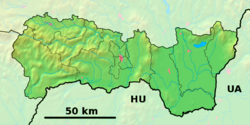Sobrance
Sobrance Szobránc | |
|---|---|
 Greek Catholic Church of the Holy Seven Slavonic Saints | |
Location of Sobrance in the Košice Region Location of Sobrance in Slovakia | |
| Coordinates: 48°44′N 22°11′E / 48.74°N 22.18°E | |
| Country | |
| Region | |
| District | Sobrance District |
| First mentioned | 1344 |
| Government | |
| • Mayor | Pavol Džurina |
| Area | |
• Total | 10.68 km2 (4.12 sq mi) |
| Elevation | 123 m (404 ft) |
| Population (2021)[3] | |
• Total | 5,848 |
| Time zone | UTC+1 (CET) |
| • Summer (DST) | UTC+2 (CEST) |
| Postal code | 730 1[2] |
| Area code | +421 56[2] |
| Car plate | SO |
| Website | www |
Sobrance (German: Sobranz, Hungarian: Szobránc, Rusyn: Собранцї) is a town in Košice Region, Slovakia, around 15 kilometres (9 miles) from Uzhhorod, Ukraine, and 22 kilometres (14 miles) east of Michalovce. Located in the Eastern Slovak Lowland not far from the Vihorlat Mountains, it is the easternmost town in Slovakia.
Etymology
[edit]The name comes from a Slavic personal name + patronimic suffix -ce, compare with similar Czech name Sebran ("picked up child") and Sebranice.[4] The first written record comes from 1409 (Zobranch). Older literature can mention also incorrect date 1344.[5]
History
[edit]In 1910, the town had 1216 inhabitants, 538 Hungarians and 577 Slovaks[citation needed]. Before the establishment of independent Czechoslovakia in 1918, Sobrance was part of Ung County within the Kingdom of Hungary. It became the capital city of its own district. In 1939, Sobrance was for a short time part of the Slovak Republic. As a result of the Slovak–Hungarian War of 1939, it was again part of Hungary from 1939 to 1944. During the Second World War the town was heavily damaged. On 23 November 1944, the Red Army entered Sobrance and it was once again part of Czechoslovakia, but did not immediately regain its district status. Since the Dissolution of Czechoslovakia, Sobrance has been part of independent Slovakia. It regained its district town status in 1996.
The first reference to Jewish residents appears in the May 15, 1739 Jewish Conscription of Ung County which recorded only one Jewish family. The head of the household was Marko Joseffovics (Marko the son of Josef), a distiller of whisky (palinka, slivovica or vodka). By July 1746 there were two Jewish families—Marko Joseffovics and Hersko Abrahamovics (Hersko the son of Abraham). The Chevra Kadisha or burial society was founded in about 1780, a time when the Jewish population of northeastern Hungary began to grow due to migrations from Galicia. Their percentage stood at 24.3% in 1910. Menashe Simcha Friedman (b.1855- d.1926) was the town Rabbi and was known as the Sobrance Rov.[6] The synagogue, which was still standing in 1929, was built in about 1800.[7] Following the Nazi invasion of Hungary on May 17, 1944, all of the Jews living in Sobrance were deported to Auschwitz concentration camp as part of the Final Solution where most were murdered upon arrival.[8] The property and belongings that were left behind were looted in a thoroughly organized act by the local non-Jewish population of Sobrance soon after the deportation.[9]
Sights
[edit]To the north of the town is Sobranecké kúpele, once a popular spa before the First World War. Today it is totally abandoned.
A Guitar museum is located in the town. The collection includes more than 200 guitars mainly from the period of 1947–1980. Perhaps the most valuable guitar is a Resonet Grazioso/Futurama from early in the career of George Harrison.
An Eastern Catholic Church of the Holy Seven Slavonic Saints (Sedmočislenici) was built in the town. It is a modern church building based on traditional Byzantine architecture models.
Demographics
[edit]| Year | Pop. | ±% |
|---|---|---|
| 1970 | 3,394 | — |
| 1980 | 3,896 | +14.8% |
| 1991 | 5,754 | +47.7% |
| 2001 | 6,262 | +8.8% |
| 2011 | 5,981 | −4.5% |
| 2021 | 5,875 | −1.8% |
| Source: Censuses[10][11] | ||
According to the 2001 census, the town had 6,262 inhabitants. 95.37% of inhabitants were Slovaks, 0.91% Roma, 0.51% Czechs and 0.37% Ukrainian.[12] The religious makeup was 51.09% Roman Catholics, 33.93% Greek Catholics, 3.59% people with no religious affiliation and 3.37% Orthodox.[12]
Twin towns – sister cities
[edit]Notable people
[edit]- Julij Feldesi (1875–1947), Rusyn printer and politician
See also
[edit]References
[edit]- ^ "Hustota obyvateľstva - obce [om7014rr_ukaz: Rozloha (Štvorcový meter)]". www.statistics.sk (in Slovak). Statistical Office of the Slovak Republic. 2022-03-31. Retrieved 2022-03-31.
- ^ a b c "Základná charakteristika". www.statistics.sk (in Slovak). Statistical Office of the Slovak Republic. 2015-04-17. Retrieved 2022-03-31.
- ^ "Počet obyvateľov podľa pohlavia - obce (ročne)". www.statistics.sk (in Slovak). Statistical Office of the Slovak Republic. 2022-03-31. Retrieved 2022-03-31.
- ^ Kiss, Lajos (1978). Földrajzi nevek etimológiai szótára (in Hungarian). Budapest: Akadémiai. p. 617.
- ^ "História mesta". Sobrance - The Official Website. Mesto Sobrance. April 30, 2005. Retrieved June 30, 2019.
- ^ "Menashe Simcha Friedman 1855-1926 - Ancestry®". Ancestry.com.
- ^ "Szobrancz, Hungary (Sobrance, Slov.) A Short History of the Jewish Community". Archived from the original on 2008-06-12. Retrieved 2009-10-31.
- ^ degob.org Archived 2012-02-15 at the Wayback Machine
- ^ degob.org
- ^ "Statistical lexikon of municipalities 1970-2011" (PDF) (in Slovak).
- ^ "Census 2021 - Population - Basic results". Statistical Office of the Slovak Republic. 2021-01-01.
- ^ a b "Municipal Statistics". Statistical Office of the Slovak republic. Retrieved 2007-12-14.
- ^ "Partnerské mestá". sobrance.sk (in Slovak). Sobrance. Retrieved 2019-09-04.


 French
French Deutsch
Deutsch


